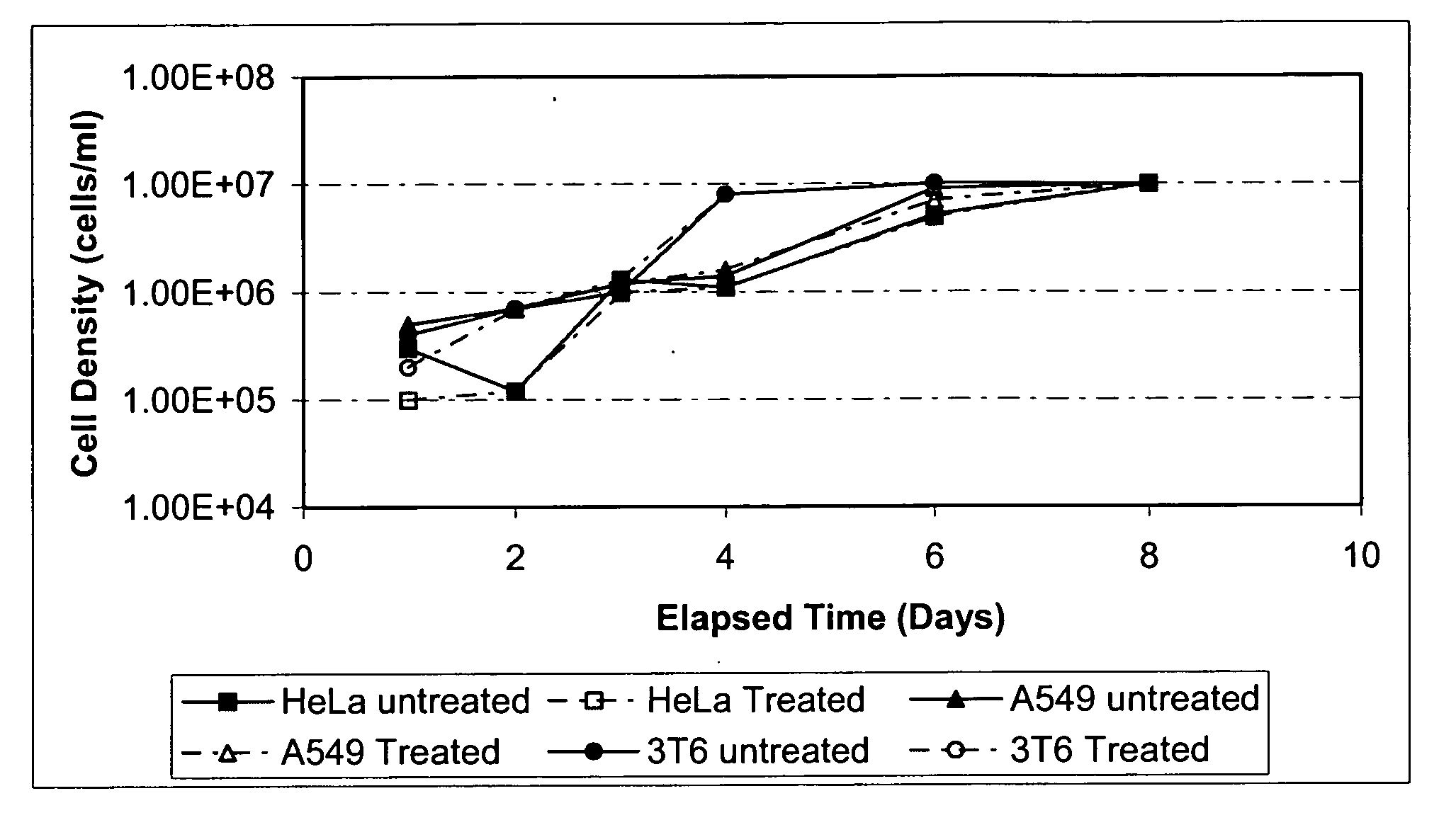Compositions, methods and apparatus for supercritical fluid virus inactivation
a supercritical fluid virus and supercritical fluid technology, applied in biochemistry apparatus and processes, microbiological testing/measurement, chemicals, etc., to achieve the effects of reducing the time of virus inactivation, minimizing protein loss, and minimizing shear forces
- Summary
- Abstract
- Description
- Claims
- Application Information
AI Technical Summary
Benefits of technology
Problems solved by technology
Method used
Image
Examples
example 1
[0025] Several tests were performed with murine-C retrovirus (MuLV), and nitrous oxide at 2,200 psig and 22° C. MuLV, an enveloped or lipid-encased virus that has an outer diameter of approximately 100 nanometers (nm), is often used as a surrogate for the human immunodeficiency virus (HIV). Selected results are presented in Table 1.
TABLE 1SCONCF CFI INACTIVATION OF MURINE LEUKEMIAVIRUS (MULV) WITH NITROUS OXIDE INLAMINAR FLOW INJECTION UNITParametersCFI-286CFI-380CFI-381CFI-464Pressure (psig)2,0002,0002,0002,000Temperature (° C.)22222222Time (mins)Titer Control1 × 104.01 × 106.01 × 103.01 × 105.5 Titer After1 × 103.01 × 103.71 × 101.00 × 100.0*−log10 reduction1.02.32.0>5.5No. of Stages0112
*below minimum detection level
[0026] CFI-286 was performed by directly passing the pressurized stream through the backpressure regulator without having contacted that stream with nitrous oxide. This zero (0) stage experiment resulted in about 1 log inactivation. Experiments CFI-380 and CFI-381 w...
example 2
[0027] Several tests were performed with vesicular stomatitis virus (VSV) and nitrous oxide at 2,200 psig and 22° C. VSV is an enveloped virus with a distinctive bullet shape (50-95 nm×130-380 nm). VSV is a member of the Rhabdovirus family. VSV possess a negative-strand RNA genome and codes for only five proteins that are found in the virion. VSV is an animal pathogen that grows well in cell culture; the host cell for VSV is the A549 cell line. Quantitation was carried out using an infectivity titration assay (50% end point referred to as TCID50); titration was performed on overnight cultures of A549 host cells. Selected results are presented in Table 2.
TABLE 2SCONCF CFI INACTIVATION OF VESICULARSTOMATITIS VIRUS (VSV) WITH NITROUS OXIDEIN LAMINAR FLOW INJECTION UNITParametersCFI-574CFI-588Pressure (psig)4,0004,000Temperature (° C.)4040Time (mins)Titer Control1 × 105.01 × 105.5 Titer After1 × 102.50 × 100.0*−log10 reduction2.5>5.5No. of Stages12
*below minimum detection level
[0028]...
example 3
[0029] Several experiments were conducted with encephalomyocarditis (EMC), a tough, prototypical non-enveloped or protein-encased virus with different SCoNCF at different pressures and temperatures in the single stage laminar flow unit. EMC, a member of the Picomaviridae family, is a positive-strand RNA virus, which lacks an envelope. EMC is icosahedral in shape with a size of 20 to 30 nanometers. EMC, an animal virus that is non-pathogenic to man, is often used as a surrogate for Hepatitis A and a marker virus in process validation studies. Other viruses of major concern belonging to the Picomaviridae family include Hepatitis A, Polioviruses and Parvoviruses. Quantitation was carried out using an infectivity titration assay (50% end point referred to as TCID50) on susceptible host cells A549, a cell line derived from human carcinoma tissue. A sample of the experimental results is listed in Table 3.
TABLE 3SCONCF CFI INACTIVATION OF ENCEPHALOMYOCARDITIS(EMC) WITH FREON-22 IN SINGLE...
PUM
| Property | Measurement | Unit |
|---|---|---|
| temperature | aaaaa | aaaaa |
| temperature | aaaaa | aaaaa |
| temperature | aaaaa | aaaaa |
Abstract
Description
Claims
Application Information
 Login to View More
Login to View More - R&D
- Intellectual Property
- Life Sciences
- Materials
- Tech Scout
- Unparalleled Data Quality
- Higher Quality Content
- 60% Fewer Hallucinations
Browse by: Latest US Patents, China's latest patents, Technical Efficacy Thesaurus, Application Domain, Technology Topic, Popular Technical Reports.
© 2025 PatSnap. All rights reserved.Legal|Privacy policy|Modern Slavery Act Transparency Statement|Sitemap|About US| Contact US: help@patsnap.com



